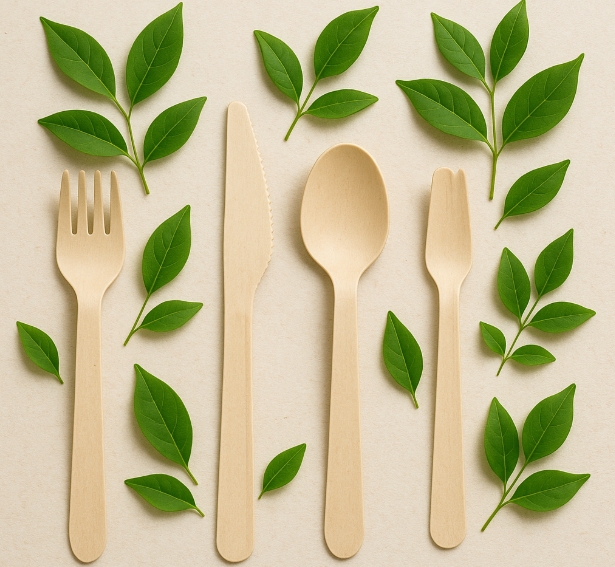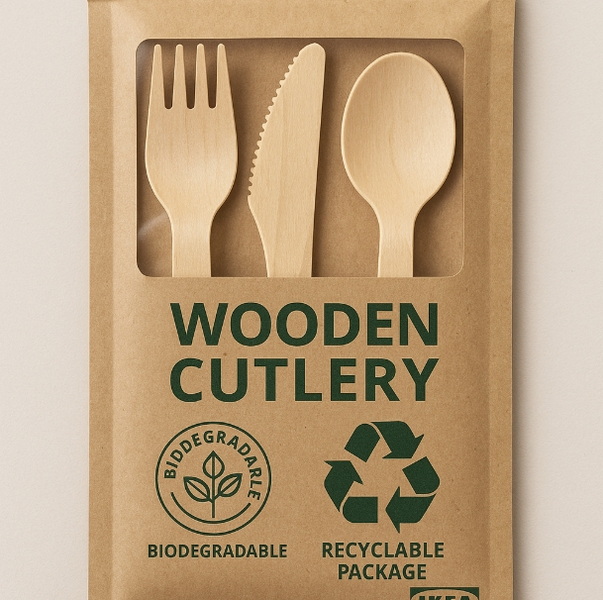
Content Menu
● The Problem with Traditional Disposable Cutlery
● IKEA's Sustainability Commitment
>> Eliminating Single-Use Plastics
>> Introduction of Sustainable Alternatives
● What Is IKEA Disposable Cutlery Made Of?
>> Wooden Cutlery
>> Why Wood?
● Environmental Impact of IKEA Disposable Cutlery
>> Production and Sourcing
>> Manufacturing Process
>> Use and Disposal
>> End-of-Life Considerations
● Comparing IKEA Disposable Cutlery to Other Alternatives
● Health and Safety Considerations
● Challenges and Limitations
● IKEA's Broader Environmental Initiatives
● The Future of Disposable Cutlery
● Consumer Awareness and Responsibility
● Innovations in Sustainable Materials
● The Role of Policy and Regulation
● Encouraging Reusability
● Conclusion
● FAQ
>> 1. What materials are used in IKEA disposable cutlery?
>> 2. Is IKEA disposable cutlery compostable?
>> 3. How does IKEA ensure the safety of its disposable cutlery?
>> 4. Can IKEA disposable cutlery be recycled?
>> 5. Why did IKEA stop using plastic cutlery?
The global shift towards sustainability has put single-use products under intense scrutiny, especially in the food service industry. Among these, disposable cutlery is a major concern due to its environmental impact. IKEA, a brand known for affordable home furnishings, has made significant changes in its approach to disposable cutlery in recent years. This article explores whether IKEA disposable cutlery is truly safe for the environment, examining its materials, production, disposal, and broader ecological footprint.

The Problem with Traditional Disposable Cutlery
Disposable cutlery, particularly plastic forks, knives, and spoons, has long been a staple of convenience culture. However, the environmental cost is staggering. Traditional plastic utensils are made from petroleum-based materials, which require significant fossil fuel extraction and energy-intensive manufacturing processes. Once used, these items are often too small and lightweight to be recycled efficiently, leading them to accumulate in landfills or, worse, pollute waterways and oceans. Plastic cutlery can take centuries to decompose, breaking down into microplastics that contaminate ecosystems and food chains.
IKEA's Sustainability Commitment
Eliminating Single-Use Plastics
Recognizing the environmental threat posed by single-use plastics, IKEA launched a comprehensive sustainability strategy. By January 2020, IKEA had phased out all single-use plastic products from its home furnishing range, restaurants, and bistros worldwide. This move was driven by the company's “People and Planet Positive” initiative, which aims to use only recycled or renewable raw materials by 2030.
Introduction of Sustainable Alternatives
To replace plastic cutlery, IKEA introduced disposable cutlery made from renewable materials, primarily responsibly sourced wood. The company also rolled out paper-based cups and straws, ensuring that all paper products are certified by the Forest Stewardship Council (FSC). These changes reflect a broader commitment to reducing plastic pollution and encouraging consumers to adopt more sustainable habits.
What Is IKEA Disposable Cutlery Made Of?
Wooden Cutlery
IKEA's disposable cutlery is now primarily made from wood. This wood is sourced from sustainably managed forests, as certified by organizations like the FSC. The production process emphasizes minimal waste, eco-friendly coatings, and responsible harvesting practices to ensure that the environmental footprint is as low as possible.
Why Wood?
Wooden cutlery offers several environmental advantages over plastic:
- Biodegradability: Unlike plastic, wooden cutlery decomposes naturally within months to years, returning to the earth without leaving toxic residues or microplastics.
- Renewable Resource: Wood can be replenished through responsible forestry, supporting biodiversity and reducing reliance on fossil fuels.
- Lower Carbon Footprint: The production of wooden cutlery generally emits fewer greenhouse gases compared to plastic manufacturing, especially when sourced and processed sustainably.
Environmental Impact of IKEA Disposable Cutlery
Production and Sourcing
The environmental safety of IKEA disposable cutlery begins with its sourcing. By using wood from responsibly managed forests, IKEA helps conserve natural resources and supports local communities. The FSC certification ensures that forests are not over-exploited and that biodiversity is maintained.
Manufacturing Process
Sustainable manufacturing practices further reduce the environmental impact. IKEA's wooden cutlery is produced with minimal waste and, where possible, uses eco-friendly coatings that do not hinder biodegradability. This approach contrasts sharply with the energy-intensive and polluting processes involved in producing plastic cutlery.
Use and Disposal
Wooden cutlery is designed for single use but can be composted or disposed of with organic waste, where it breaks down much faster than plastic alternatives. In industrial composting facilities, wooden utensils can decompose within a few months, whereas plastic cutlery can persist for hundreds or even thousands of years.
End-of-Life Considerations
The end-of-life impact is a critical factor in assessing environmental safety. Wooden cutlery, when disposed of properly, does not contribute to microplastic pollution or toxic leachates. Even if it ends up in a landfill, its natural decomposition is far less damaging than that of plastic utensils.

Comparing IKEA Disposable Cutlery to Other Alternatives
| Feature | IKEA Wooden Cutlery | Traditional Plastic Cutlery | Bioplastic Cutlery |
| Material Source | Renewable (wood) | Fossil fuels (petroleum) | Renewable (plant-based) |
| Biodegradability | Yes (months to years) | No (centuries) | Varies (often industrial) |
| Compostability | Yes (home/industrial) | No | Sometimes (industrial) |
| Carbon Footprint | Low (if responsibly made) | High | Moderate |
| Microplastic Pollution | No | Yes | Possible (if not composted) |
| Eco-Certification | FSC-certified | Rare | Sometimes |
Health and Safety Considerations
IKEA's approach to disposable cutlery is not only about environmental safety but also consumer health. The company has proactively phased out harmful chemicals, such as Bisphenol A (BPA), from all food contact products, including cutlery, since as early as 2012. This ensures that IKEA disposable cutlery is free from substances that could pose risks to human health or the environment.
Challenges and Limitations
While wooden cutlery is a major improvement over plastic, it is not without challenges:
- Resource Use: Even renewable resources like wood must be managed carefully to avoid deforestation or habitat loss.
- Composting Infrastructure: Not all regions have access to industrial composting facilities, which can limit the environmental benefits if wooden cutlery ends up in general waste.
- Consumer Behavior: The ultimate environmental benefit depends on responsible use and disposal by consumers. Education and awareness are crucial to maximize the positive impact.
IKEA's Broader Environmental Initiatives
IKEA's commitment to sustainability extends beyond disposable cutlery. The company is investing in renewable energy, sustainable food options, and innovative materials. For instance, IKEA is exploring the use of ocean-bound plastics in new products and has partnered with global initiatives to prevent plastic waste from entering waterways.
The Future of Disposable Cutlery
The elimination of single-use plastic cutlery by IKEA sets a benchmark for the industry. As more companies follow suit, the demand for sustainable alternatives will drive innovation and further reduce the environmental impact of disposable products. However, the most sustainable option remains the use of reusable cutlery whenever possible, reducing waste at its source.
Consumer Awareness and Responsibility
Consumer behavior plays a crucial role in the environmental impact of disposable cutlery. While IKEA provides sustainable options, the effectiveness of these products depends largely on how consumers use and dispose of them. Educating consumers about proper disposal methods, such as composting or recycling where available, can significantly enhance the environmental benefits. IKEA has also been active in promoting awareness campaigns to encourage responsible consumption and waste management.
Innovations in Sustainable Materials
The future of disposable cutlery lies in continuous innovation. Researchers and companies are exploring new materials such as biodegradable bioplastics derived from plant starches, algae-based plastics, and even edible cutlery. IKEA is monitoring these developments closely and may incorporate such materials into their product lines as they become viable and environmentally sound. These innovations promise to further reduce the carbon footprint and waste associated with disposable utensils.
The Role of Policy and Regulation
Government policies and regulations are essential in driving the shift towards sustainable disposable products. Many countries have introduced bans or taxes on single-use plastics, which encourage companies like IKEA to adopt greener alternatives. Continued regulatory support will be vital to ensure that sustainable products are accessible and affordable for consumers worldwide.
Encouraging Reusability
While disposable cutlery alternatives are a step forward, the most sustainable option remains reusable cutlery. IKEA also offers a range of reusable cutlery products made from durable materials such as stainless steel and bamboo. Promoting the use of reusable items can drastically reduce waste and environmental impact over time.
Conclusion
IKEA disposable cutlery represents a significant step forward in environmental responsibility. By phasing out single-use plastics and introducing wooden alternatives sourced from sustainably managed forests, IKEA has reduced the ecological footprint of its food service operations. While no disposable product is entirely without impact, IKEA disposable cutlery is far safer for the environment than traditional plastic options. Its biodegradability, renewable sourcing, and absence of harmful chemicals make it a responsible choice for consumers seeking convenience without compromising the planet's health. The journey towards sustainability is ongoing, but IKEA's actions demonstrate that large-scale change is possible when companies prioritize people and the planet.

FAQ
1. What materials are used in IKEA disposable cutlery?
IKEA disposable cutlery is made from responsibly sourced wood, certified by organizations like the Forest Stewardship Council. This ensures the wood is harvested sustainably, supporting both environmental and social goals.
2. Is IKEA disposable cutlery compostable?
Yes, IKEA wooden cutlery is compostable under the right conditions. It can break down naturally in home or industrial composting facilities, returning nutrients to the soil without leaving toxic residues.
3. How does IKEA ensure the safety of its disposable cutlery?
IKEA evaluates all materials for safety, quality, and sustainability before use. The company has proactively removed harmful chemicals such as BPA from all food contact products, ensuring that its disposable cutlery is safe for both consumers and the environment.
4. Can IKEA disposable cutlery be recycled?
While wooden cutlery is not typically recycled in the same way as plastics or metals, it can be composted. If composting is not available, it will still biodegrade much faster than plastic alternatives when disposed of in regular waste.
5. Why did IKEA stop using plastic cutlery?
IKEA stopped using plastic cutlery to reduce plastic pollution and its environmental impact. The move is part of a broader sustainability strategy aimed at eliminating single-use plastics and using only recycled or renewable materials by 2030.

















